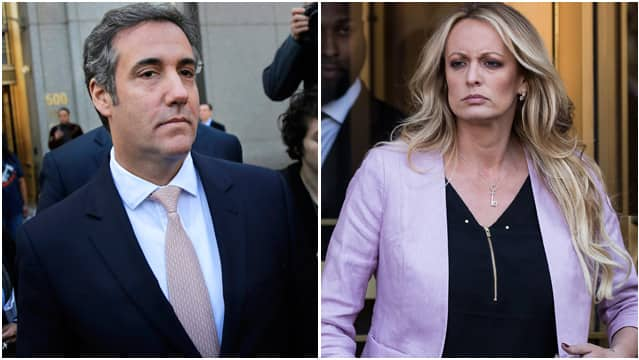Seven jurors were empanelled by the second day of Donald Trump’s trial Tuesday, leaving only five slots plus several backups unfilled.
It was faster than most had predicted for the historic and unusual criminal trial.
Analysts had predicted it might take two weeks or more to select a jury for the highest-ranking U.S. politician ever to face a criminal trial.
Regular citizens were grilled over old social media posts and political opinions. Some cracked under questioning, but a handful survived.
Empanelling a jury has been challenge No. 1 in the trial of Trump. People from myriad walks of life were asked for their opinion on one of the most opinion-generating humans on Planet Earth.
“[Everyone knows Trump] unless you’ve been living under a rock for the last eight years, or the last 30 years,” assistant prosecutor Josh Steinglass told potential jurors.
This New York case, alleging Trump falsified business records, could be the only one of Trump’s four cases headed to trial before this year’s U.S. election.
It’s begun with a tussle over what the jury looks like in a place where he’s deeply disliked: In his former home of Manhattan, he drew just 12 per cent of the vote in 2020.
To begin the trial, the court needs five more jurors, plus a handful of alternates. The process could still last throughout the week, with Wednesday an off day.
Dismissals for bias
The vast majority of people were dismissed, most for potential bias. Scores of others withdrew themselves, admitting they couldn’t be impartial on Trump.
Making things more awkward: Trump was staring at these people while they answered.
He’d sit stone-faced through some replies and smile at others — like when candidates said they’d read his books or watched his TV show.
Some candidates danced around political questions with the skill of a presidential contender.
When asked for his view of Trump, one offered a colourful non-answer: The former president sure does elicit strong opinions.
“He sets people off — one way or another,” the man replied. “I find that really interesting. Really — ‘This one guy can do all of this? Wow.’ That’s what I think.”

Another played cat-and-mouse with Trump’s defence lawyer as he tried getting at the jury candidate’s political opinions.
He said he’d share his views on Trump if they were sitting in a bar, but not here. He insisted this case is unconnected to his politics: “They’re apples and oranges.”
Finally, after several attempts, the man, a tech software salesman, conceded: “I’ll say I’m a Democrat.” He was the same man who had earlier made Trump smile, by saying he’d read The Art of the Deal, and some of his other books.
Several potential jurors were asked to explain old social media posts, like one showing video of street celebrations after Trump’s 2020 election defeat.
It was at that point that Trump got upbraided by the judge; he murmured something inaudible to the post author and was scolded.
“I won’t tolerate that. I will not have any jurors intimidated in this court,” Justice Juan Merchan said.
Another candidate was dismissed over a 2017 post about the so-called Muslim ban that said, “Good news! Trump lost his court battle on his unlawful travel ban!!… Lock him up.”
Separately, for more subjective cases, the prosecution and defence are each allowed to reject up to 10 candidates; both sides used some of their challenges Tuesday.
And that’s how an initial pool of 96 was whittled down to just seven, with a new pool of 96 candidates sworn in Tuesday afternoon.
Stage 1: Questionnaire
The jury selection process is an ordeal in three stages: A questionnaire, a panel discussion and a grilling.
Candidates who survive those three rounds make it onto the jury.
The search is on in a New York court for jurors to serve in former U.S. president Donald Trump’s first criminal trial. Hear from one potential juror about what it was like in the courtroom, where lawyers are seeking unbiased jurors for this very high-profile case.
Most never even got to the starting line, with more than 50 admitting Monday they were too biased to judge Trump fairly, and a few more saying the same Tuesday.
Others were excused for non-political reasons. Like Kara McGee, who works in cybersecurity and convinced the judge that absence from her job could do professional damage.
Another told the judge she had to attend her sister’s wedding in September. A software engineer at Disney, she asked if this would be a problem.
The judge, who wants the case wrapped up this spring, shot back with a quip: “If we’re still here in September, that would be a big problem.”
Then come three tests.
Individual candidates are asked to read out their answers to a 42-question form produced by the judge. It asks what news they read, whether they have any conflicts of interest, and whether they can judge Trump fairly.
Stage 2: Panel discussion
The second step resembles a panel discussion. Like a cross between episodes of The Oprah Winfrey Show and The People’s Court.
The prosecution and defence are given 30 minutes with groups of candidates. The lawyers give monologues, ask questions and hand the microphone to potential jurors.
The prosecutor told candidates their political feelings were immaterial: “This case is about whether that man broke the law,” Steinglass said.
He also pre-emptively tackled one potential weak spot for the prosecution: the credibility of witnesses.
He told jurors witnesses include a convicted perjurer, former Trump fixer Michael Cohen; a porn star who’d changed her story, Stormy Daniels; and a tabloid magnate, David Pecker.
After documents were released by Stormy Daniels’s lawyer allegedly linking Trump’s personal lawyer Michael Cohen to a Russian oligarch, many are saying the cases of the porn star and Russian election meddling are converging. CBC’s Wendy Mesley speaks to former White House ethics lawyer Richard Painter about what he calls Trump’s ‘bagman’ making America look like a ‘banana republic.’
“Several … have what you might consider some baggage,” he said, asking whether jurors would listen to a witness who’d lied before.
Trump lawyer Todd Blanche insisted he didn’t want candidates’ political views. Then he pressed repeatedly for candidates’ political views. He assured them: “There are no wrong answers. You’re not going to offend me.”
They didn’t offend him. But some did give him ammunition. Later, Blanche came back to court, suggesting some candidates had been untruthful.
Stage 3: Grilling
Step 3 came after lunch.
Blanche returned with printouts of social media posts, alleging inconsistencies between the posts and some candidates’ professed impartiality or apolitical leanings.
In some cases, he successfully had a candidate disqualified, like the one who posted a meme about jailing Trump. The judge brushed him off for others.
One involved a Facebook post by a jury candidate’s husband.
It was from 2016, with a photo of Barack Obama and Trump. In a joke about the presidents’ skin tones, and a Netflix TV show title, the post said something like: “This isn’t what people meant by Orange Is The New Black.”
“These are posts from over eight years ago,” Merchan said. “Not involving the juror, involving the juror’s husband.”
If this was the best the defence could come up with, Merchan said, it made him all the more confident in the candidate’s ability to be fair and impartial.
The trial resumes Thursday.
Source Agencies





